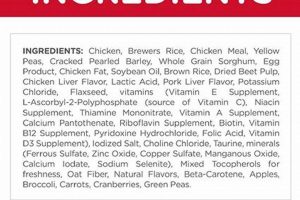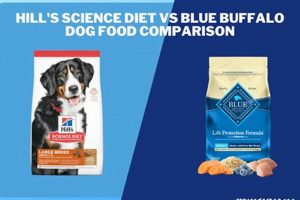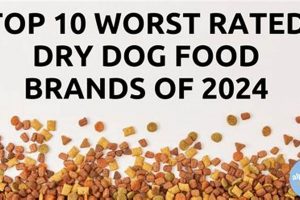Dietary formulations designed with reduced levels of a specific mineral are often recommended for canines experiencing particular health concerns. These specialized diets aim to manage the intake of this mineral, which plays a crucial role in various bodily functions, including bone health and energy metabolism. An example is a canine food formula containing limited amounts of the mineral to support renal function in dogs with kidney disease.
Limiting the quantity of this mineral in a dog’s diet can be beneficial in managing certain medical conditions, especially those affecting the kidneys. As kidney function declines, the body’s ability to filter and excrete this mineral diminishes, leading to its accumulation in the bloodstream. This accumulation can contribute to further kidney damage and other systemic complications. Carefully controlled dietary intake assists in mitigating these risks and improving the animal’s overall well-being. This dietary strategy has become an increasingly important aspect of veterinary care over the past several decades as diagnostic capabilities have improved and life expectancies for companion animals have increased.
The following sections will delve into the specific conditions that may necessitate dietary restriction of this mineral, the nutritional considerations involved in formulating such diets, and practical guidance for selecting and implementing these specialized food options for canine companions.
Guidance on Selecting Appropriate Canine Food
The following recommendations are intended to provide informational guidance for owners considering a dietary regimen tailored to limit phosphorus intake in their canine companions. Consult a veterinarian for a personalized assessment and dietary plan.
Tip 1: Consult a Veterinary Professional. A definitive diagnosis and subsequent recommendation from a qualified veterinarian are essential. The veterinarian will determine if a limited phosphorus diet is truly necessary based on the dog’s medical history, current condition, and diagnostic test results.
Tip 2: Scrutinize Ingredient Lists. Carefully review the ingredient list on potential food products. Avoid formulations that list bone meal, dicalcium phosphate, or other ingredients high in phosphorus near the top of the list. Ingredient lists are typically ordered by weight, with the most abundant ingredients listed first.
Tip 3: Analyze Nutritional Information. Pay close attention to the guaranteed analysis on the food label, specifically the percentage of phosphorus. Compare the phosphorus content across different brands and formulations to identify options with lower levels. Aim for foods that meet the specific phosphorus needs outlined by the veterinarian.
Tip 4: Prioritize Protein Quality. While limiting phosphorus, it’s crucial to ensure adequate protein intake. Opt for food formulations that utilize high-quality, easily digestible protein sources, such as lean meats or fish. This supports overall health and muscle maintenance.
Tip 5: Consider Renal Support Formulas. Many veterinary therapeutic diets formulated for dogs with kidney disease are inherently designed to be reduced in phosphorus. Explore these options, as they often incorporate other beneficial nutrients and ingredients to support renal function.
Tip 6: Transition Gradually. When introducing a new diet, transition slowly over a period of 7-10 days. Mix increasing amounts of the new food with decreasing amounts of the old food to minimize digestive upset.
Tip 7: Monitor Your Dog’s Response. Closely observe the dog’s overall health and well-being following the dietary change. Monitor appetite, energy levels, stool consistency, and any changes in clinical signs. Regular veterinary check-ups are crucial to assess the diet’s effectiveness and make any necessary adjustments.
Adhering to these suggestions ensures a strategic approach to selecting and implementing the appropriate canine food formula, aimed at maintaining the health and well-being of the animal.
The subsequent sections will provide detailed insights into specific dietary considerations and management strategies for canine patients requiring phosphorus restriction.
1. Renal Function Support
Compromised renal function, often associated with chronic kidney disease (CKD) in canines, directly impacts the body’s ability to efficiently excrete phosphorus. As kidney function declines, phosphorus accumulates in the bloodstream, leading to hyperphosphatemia. Elevated serum phosphorus levels contribute to a cascade of detrimental effects, including stimulation of parathyroid hormone (PTH) secretion, which can result in renal secondary hyperparathyroidism and further kidney damage. Dietary management, specifically through food formulas with controlled phosphorus levels, is therefore crucial for mitigating these consequences and supporting remaining kidney function. Such diets aim to reduce the phosphorus load presented to the kidneys, easing the burden on already impaired filtration mechanisms. For example, a canine diagnosed with Stage 2 CKD, based on IRIS (International Renal Interest Society) staging guidelines, would likely benefit from a diet explicitly formulated with reduced phosphorus content to manage their phosphorus levels and slow the progression of the disease.
The reduction of phosphorus in canine diets formulated for renal support provides several tangible benefits. Lowering serum phosphorus can help reduce the severity of renal secondary hyperparathyroidism, minimizing bone demineralization and associated complications. Furthermore, decreasing phosphorus intake can help mitigate soft tissue calcification, a frequent consequence of hyperphosphatemia in CKD patients. Formulations designed to support renal function often incorporate additional features beyond phosphorus restriction, such as controlled protein levels (to minimize the production of nitrogenous waste products) and added omega-3 fatty acids (to help reduce inflammation within the kidneys). A real-world application involves a geriatric canine with chronic renal insufficiency, where implementing a food reduced in phosphorus, along with regular monitoring of renal parameters, led to improved appetite, reduced vomiting, and stabilization of kidney function test results.
In summary, the connection between renal function support and dietary phosphorus management is inextricably linked in the context of canine health. Controlling dietary phosphorus intake is a cornerstone of managing CKD and slowing its progression. While phosphorus restriction is a critical component, optimal renal support requires a multifaceted approach involving careful monitoring, consideration of other dietary factors, and close collaboration with a veterinarian. Failure to address hyperphosphatemia through appropriate dietary intervention can accelerate kidney damage and negatively impact the canine’s overall quality of life. The implementation of a suitable dietary strategy represents a proactive step in safeguarding the animal’s renal health and well-being.
2. Mineral Balance
Maintaining appropriate mineral balance is paramount when formulating canine diets restricted in phosphorus. Altering the concentration of one mineral inherently impacts the absorption, excretion, and utilization of others. Therefore, careful consideration of the interactions between phosphorus and other essential minerals is critical to prevent imbalances that could compromise canine health.
- Calcium-Phosphorus Ratio
The ratio of calcium to phosphorus is of utmost importance. When dietary phosphorus is reduced, the calcium-to-phosphorus ratio must be carefully adjusted to prevent secondary hyperparathyroidism and maintain bone health. Ideally, the diet should provide adequate calcium relative to the reduced phosphorus levels. For instance, a typical adult dog diet might have a Ca:P ratio of 1:1 to 2:1. In diets with reduced phosphorus, the ratio may need to be closer to 2:1 to ensure sufficient calcium availability. Failing to maintain this balance can lead to calcium mobilization from bones to maintain serum calcium levels, potentially leading to skeletal abnormalities over time.
- Vitamin D Interaction
Vitamin D plays a crucial role in calcium and phosphorus absorption. Adequate vitamin D levels are essential to facilitate the absorption of calcium from the intestinal tract. In the context of phosphorus restriction, ensuring sufficient vitamin D is critical for optimizing calcium utilization, particularly as calcium absorption may be slightly impaired due to altered phosphorus levels. Supplementation with vitamin D may be necessary, but should be carefully managed under veterinary guidance, as excessive vitamin D can lead to hypercalcemia.
- Magnesium Considerations
Magnesium is another essential mineral that interacts with phosphorus. While not as directly linked as calcium, magnesium deficiency can exacerbate the effects of hyperphosphatemia, potentially increasing the risk of soft tissue mineralization. Formulations designed to limit phosphorus should also address magnesium levels, ensuring they are adequate to support overall health and prevent potential complications. Monitoring serum magnesium levels may be indicated in certain patients.
- Potassium Regulation
Potassium is vital for numerous bodily functions, including nerve and muscle function. While not directly related to phosphorus metabolism, potassium levels can be affected by kidney disease, which is the most common reason for needing a low phosphorus diet. Some kidney conditions can lead to potassium loss, thus diets need to be balanced to consider potential deficiencies or excesses, which can have serious health consequences.
In conclusion, formulating a canine diet restricted in phosphorus necessitates a holistic approach to mineral balance. Simply reducing phosphorus without carefully considering the interactions with other minerals, particularly calcium, vitamin D, and magnesium, can lead to unintended consequences and compromise the animal’s health. Close collaboration with a veterinary nutritionist is essential to ensure the diet meets the individual needs of the canine patient and maintains optimal mineral balance.
3. Protein Source Quality
Protein source quality plays a critical role in formulating diets designed to restrict phosphorus intake in canines. The selection of protein sources directly influences both the phosphorus content of the diet and the animal’s overall health and well-being. High-quality protein sources are essential for maintaining muscle mass, supporting immune function, and providing essential amino acids, even while phosphorus levels are carefully managed.
- Phosphorus Content Variation
Different protein sources exhibit varying phosphorus concentrations. Animal-based proteins, particularly those containing bone, tend to be higher in phosphorus than plant-based proteins. For instance, meat meals, by-product meals, and dairy products can contribute significantly to the total phosphorus content of a canine diet. Selecting lean muscle meat and carefully processing it to remove bone fragments can help reduce the phosphorus load. Plant-based protein sources such as soy, pea protein, and rice protein offer lower phosphorus alternatives, but their amino acid profiles must be carefully considered to ensure they meet the canine’s nutritional requirements.
- Amino Acid Profile Completeness
High-quality protein sources provide a complete and balanced array of essential amino acids. Essential amino acids are those that the canine body cannot synthesize on its own and must obtain from the diet. A deficiency in any essential amino acid can lead to various health problems, including muscle wasting, impaired immune function, and poor coat quality. When formulating phosphorus-restricted diets, it is crucial to select protein sources that provide all essential amino acids in adequate amounts. Combining different protein sources, such as a blend of animal and plant-based proteins, can help achieve a more complete amino acid profile. For example, supplementing rice protein with lysine can improve its overall amino acid balance.
- Digestibility and Bioavailability
The digestibility and bioavailability of protein sources influence their nutritional value. Highly digestible protein sources are more efficiently broken down and absorbed by the canine’s digestive system, maximizing the utilization of amino acids and minimizing the amount of undigested protein that reaches the colon. Undigested protein in the colon can be fermented by bacteria, leading to the production of ammonia and other potentially harmful byproducts. Selecting highly digestible protein sources, such as hydrolyzed proteins or egg protein, can help reduce the risk of digestive upset and improve nutrient absorption. Bioavailability refers to the extent to which nutrients are absorbed and utilized by the body. Factors such as processing methods, ingredient interactions, and the presence of antinutritional factors can affect protein bioavailability.
- Renal Considerations
In canines with compromised renal function, the type and quantity of protein are particularly important. While protein restriction was historically a cornerstone of managing kidney disease, current recommendations emphasize providing adequate, high-quality protein to maintain muscle mass and overall health while minimizing the production of nitrogenous waste products that the kidneys must filter. Protein sources with high biological value produce less waste than those with low biological value. Furthermore, highly digestible protein sources are less likely to contribute to azotemia (the buildup of nitrogenous waste in the blood). The protein source also needs to be of sufficient amount and high-quality to meet the dog’s needs without contributing to additional kidney stress. For instance, chicken or fish, prepared without the skin, can be a better option.
Selecting appropriate protein sources in the context of phosphorus-restricted diets is a multifaceted decision, requiring careful consideration of phosphorus content, amino acid profile, digestibility, and renal considerations. The goal is to provide adequate and high-quality protein to support the canine’s health while minimizing the phosphorus load and the burden on the kidneys. Consultation with a veterinary nutritionist is essential to develop a customized dietary plan that meets the individual needs of the patient.
4. Veterinary Supervision
The implementation of dietary strategies involving restricted phosphorus levels in canine nutrition necessitates diligent veterinary oversight. This supervision ensures the appropriateness, safety, and efficacy of such interventions, given the potential complexities and consequences associated with altering mineral balance.
- Diagnosis and Justification
Veterinary diagnosis is paramount in determining the underlying cause requiring a low-phosphorus diet. Conditions such as chronic kidney disease (CKD) or hyperparathyroidism necessitate specific dietary adjustments. A veterinarian’s assessment, based on comprehensive clinical evaluation and diagnostic testing (e.g., bloodwork, urinalysis), confirms the need for phosphorus restriction. For example, elevated serum phosphorus levels alongside reduced glomerular filtration rate would warrant consideration of such a dietary modification. Initiating a low-phosphorus diet without proper veterinary justification can lead to nutritional imbalances and adverse health outcomes.
- Individualized Dietary Recommendations
Dietary recommendations should be tailored to the individual canine patient. Factors such as age, breed, concurrent health conditions, and stage of disease progression influence the optimal phosphorus level and overall nutrient profile of the diet. A standardized, “one-size-fits-all” approach is inappropriate. A veterinarian, or a veterinary nutritionist, can formulate a specific dietary plan or recommend commercially available diets that meet the dog’s unique needs. This process may involve calculating precise macronutrient and micronutrient requirements, considering potential drug-nutrient interactions, and accounting for palatability concerns.
- Monitoring and Adjustments
Ongoing monitoring is crucial to assess the effectiveness of the low-phosphorus diet and to detect any adverse effects. Regular veterinary check-ups, including blood tests to monitor serum phosphorus, calcium, and kidney function parameters, are essential. Based on these assessments, the veterinarian can adjust the dietary plan as needed. For instance, if serum phosphorus levels remain elevated despite dietary intervention, further adjustments may be necessary, such as increasing the level of phosphorus binders or modifying the protein content of the diet. Conversely, if the dog develops hypophosphatemia (low serum phosphorus), the diet may need to be re-evaluated and adjusted to provide a higher phosphorus intake.
- Management of Complications
Veterinary supervision is essential for managing potential complications associated with phosphorus restriction. Although rare, phosphorus depletion can occur, especially with overly restrictive diets or in combination with certain medications. This can lead to muscle weakness, anemia, and other health issues. The veterinarian can identify and address these complications through appropriate diagnostic testing and treatment. Furthermore, they can guide the owner on how to prevent such complications by carefully monitoring the dog’s overall health and following the prescribed dietary recommendations.
In summary, veterinary supervision is an indispensable component of managing canine health through low-phosphorus dietary interventions. It encompasses accurate diagnosis, individualized dietary planning, continuous monitoring, and proactive management of potential complications. The veterinarian serves as a crucial resource for ensuring the safety and efficacy of this dietary strategy, maximizing the benefit to the canine patient.
5. Dietary Stage Adaptation
The dietary management of canines requiring phosphorus restriction necessitates a dynamic approach, adapting the dietary plan according to the stage of disease progression or changes in the animal’s physiological status. This “Dietary Stage Adaptation” is crucial for optimizing the effectiveness of the “low phosphorus dog food” and maintaining the canine’s overall health and well-being. Failure to adjust the diet appropriately can lead to suboptimal outcomes, potentially accelerating disease progression or causing adverse side effects. The causal link between dietary phosphorus levels and disease state dictates the adaptation process. For example, a canine newly diagnosed with early-stage chronic kidney disease (CKD) may require a moderately restricted phosphorus diet, while a canine with advanced CKD may need a more severely restricted phosphorus intake to manage hyperphosphatemia effectively.
The practical significance of Dietary Stage Adaptation is particularly evident in managing chronic kidney disease (CKD), the most common indication for restricted-phosphorus diets. The International Renal Interest Society (IRIS) staging system provides a framework for classifying the severity of CKD based on serum creatinine levels and other parameters. Each stage of CKD may require a different level of phosphorus restriction. Additionally, other factors such as proteinuria, blood pressure, and the presence of concurrent conditions must be considered when tailoring the dietary plan. For instance, a dog with Stage 3 CKD and significant proteinuria may benefit from a diet with moderate protein restriction in addition to phosphorus control, whereas a dog with Stage 2 CKD and no proteinuria may tolerate a higher protein intake. Regular monitoring of renal parameters and clinical signs is essential to guide dietary adjustments and ensure that the diet continues to meet the animal’s changing needs. Real-life examples illustrate the point, such as a dog that initially responded well to a moderately restricted phosphorus diet but subsequently developed worsening hyperphosphatemia as its kidney disease progressed. This scenario would necessitate a reduction in dietary phosphorus to maintain serum phosphorus levels within the target range.
In conclusion, Dietary Stage Adaptation constitutes an indispensable component of successful phosphorus management in canines. Recognizing the dynamic nature of disease processes and physiological states is paramount for tailoring the dietary plan to the animal’s evolving needs. The integration of regular monitoring, veterinary oversight, and a flexible approach to dietary adjustments ensures that the low phosphorus diet remains effective in supporting the canine’s health and mitigating the potential complications associated with phosphorus imbalances. Challenges remain in predicting the precise rate of disease progression and individual responses to dietary interventions, underscoring the need for ongoing research and refinement of dietary recommendations. Ultimately, the adoption of a proactive and adaptive approach to dietary management optimizes the benefits of low phosphorus formulations in canine patients.
Frequently Asked Questions About Low Phosphorus Dog Food
The following are answers to common questions regarding the use of dietary formulations containing reduced phosphorus for canine consumption. The information presented aims to clarify appropriate use, potential benefits, and relevant considerations.
Question 1: What specific medical conditions warrant the use of food formulas with limited phosphorus?
These specially formulated food options are most commonly indicated for canines diagnosed with chronic kidney disease (CKD). As kidney function declines, the body’s ability to regulate phosphorus levels diminishes, leading to hyperphosphatemia, which can exacerbate kidney damage and contribute to other health problems. Less common, but still relevant, conditions include certain types of hyperparathyroidism and specific instances of bladder stone formation.
Question 2: How significant is the phosphorus reduction in specialized food products compared to standard canine diets?
The degree of phosphorus reduction varies depending on the specific product and the targeted medical condition. Therapeutic renal diets typically contain significantly lower phosphorus levels than maintenance diets, often ranging from 0.2% to 0.5% phosphorus on a dry matter basis. The appropriate level of reduction should be determined in consultation with a veterinarian based on the individual animal’s needs.
Question 3: Are there potential risks associated with feeding a low phosphorus diet to a healthy canine?
Feeding a diet with restricted phosphorus to a healthy canine is generally not recommended, as it can lead to phosphorus deficiency and potentially impair bone development, muscle function, and energy metabolism. Adequate phosphorus intake is essential for maintaining overall health and well-being. Unless a veterinarian specifically recommends phosphorus restriction due to a diagnosed medical condition, standard maintenance diets are more appropriate for healthy animals.
Question 4: How can owners effectively transition their canine to a new dietary regimen with limited phosphorus?
A gradual transition is crucial to minimize the risk of digestive upset. It is generally recommended to mix increasing amounts of the new diet with decreasing amounts of the old diet over a period of 7-10 days. Start with a small proportion of the new diet (e.g., 25%) and gradually increase the amount each day until the transition is complete. Monitor the animal’s appetite, stool consistency, and overall health during the transition.
Question 5: Are there alternative methods, besides specialized food, to manage phosphorus levels in canines?
In addition to dietary management, phosphorus binders may be prescribed by a veterinarian to help reduce phosphorus absorption from the digestive tract. These medications are typically administered with meals and bind to phosphorus in the gut, preventing its absorption into the bloodstream. The use of phosphorus binders is often indicated in cases where dietary restriction alone is insufficient to control hyperphosphatemia.
Question 6: What other dietary modifications might be recommended alongside food formulations with limited phosphorus?
Depending on the underlying medical condition, other dietary modifications may be recommended in conjunction with food options containing reduced phosphorus. These modifications may include controlled protein levels, increased omega-3 fatty acids, and restricted sodium intake. A comprehensive dietary plan should be developed in consultation with a veterinarian to address the animal’s specific needs and optimize overall health.
Careful monitoring and close collaboration with a veterinary professional are essential when implementing and maintaining a dietary plan involving restricted phosphorus.
The subsequent section will delve into specific product selection guidance and offer insight into deciphering product labeling and ingredient lists.
The Necessity of Phosphorus Restriction in Canine Diets
This exploration of formulations designed for limited phosphorus consumption underscores their critical role in managing specific canine health conditions. The interplay between dietary phosphorus, renal function, mineral balance, and protein quality necessitates a comprehensive understanding for informed decision-making. Effective implementation relies on veterinary supervision and the adaptation of dietary strategies based on the individual animal’s needs.
Continued research and refinement of dietary recommendations are essential to optimize canine health through phosphorus management. Diligent monitoring, informed product selection, and proactive veterinary care remain paramount in ensuring the well-being of canine companions requiring dietary phosphorus restriction.


![Best Gravy for Dogs Dry Food? + [Tips & Guide] World’s Most Delicious Foods: Must-Try Dishes from Every Country Best Gravy for Dogs Dry Food? + [Tips & Guide] | World’s Most Delicious Foods: Must-Try Dishes from Every Country](https://lisasfoods.com/wp-content/uploads/2025/12/th-772-300x200.jpg)




